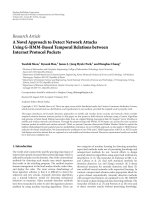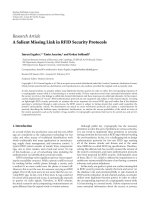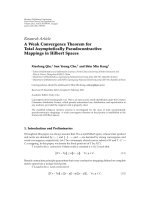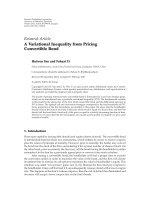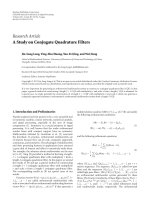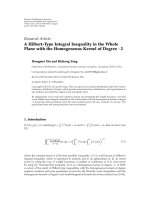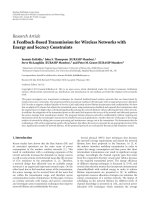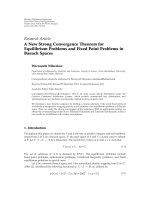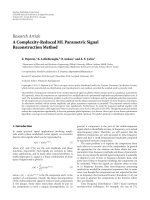Báo cáo hóa học: " Research Article A T-S Fuzzy Model-Based Adaptive Exponential Synchronization Method for Uncertain " docx
Bạn đang xem bản rút gọn của tài liệu. Xem và tải ngay bản đầy đủ của tài liệu tại đây (799.66 KB, 14 trang )
Hindawi Publishing Corporation
Journal of Inequalities and Applications
Volume 2010, Article ID 168962, 14 pages
doi:10.1155/2010/168962
Research Article
A T-S Fuzzy Model-Based Adaptive Exponential
Synchronization Method for Uncertain Delayed
Chaotic Systems: An LMI Approach
Choon Ki Ahn
Department of Automotive Engineering, Seoul National University of Science and Technology,
172 Gongneung 2-dong, Nowon-gu, Seoul 139-743, Republic of Korea
Correspondence should be addressed to Choon Ki Ahn,
Received 22 April 2010; Revised 30 July 2010; Accepted 21 September 2010
Academic Editor: Ond
ˇ
rej Do
ˇ
sl
´
y
Copyright q 2010 Choon Ki Ahn. This is an open access article distributed under the Creative
Commons Attribution License, which permits unrestricted use, distribution, and reproduction in
any medium, provided the original work is properly cited.
This paper proposes a new fuzzy adaptive exponential synchronization controller for uncertain
time-delayed chaotic systems based on Takagi-Sugeno T-S fuzzy model. This synchronization
controller is designed based on Lyapunov-Krasovskii stability theory, linear matrix inequality
LMI, and Jesen’s inequality. An analytic expression of the controller with its adaptive laws of
parameters is shown. The proposed controller can be obtained by solving the LMI problem. A
numerical example for time-delayed Lorenz system is presented to demonstrate the validity of the
proposed method.
1. Introduction
Chaos synchronization is an important subject both theoretically and practically, for
applications requiring oscillations out of chaos, machine and building structural stability
analysis, chaos generators design and so on. Chaos synchronization, first described by
Fujisaka and Yamada 1 in 1983, did not received great attention until 1990 2. From then
on, chaos synchronization has been developed extensively due to its various applications
3. During the last decade, several techniques for handling chaos synchronization have been
developed, such as variable structure control 4, OGY method 5, observer-based control
6, active control 7, backstepping design technique 8, H
∞
approach 9, and passivity
based method 10.
Time delay inevitably appears in many physical systems such as aircraft, chemical,
and biological systems. Unlike ordinary differential equations, time delayed systems are
2 Journal of Inequalities and Applications
infinite dimensional in nature and time-delay is, in many cases, a source of instability. The
stability issue and the performance of time delayed systems are, therefore, both of theoretical
and practical importance. Since Mackey and Glass 11 first found chaos in time delayed
system, there has been increasing interest in time delayed chaotic systems 12, 13.The
synchronization problem for time delayed chaotic systems is also investigated by several
researchers 14–20.
In recent years, fuzzy logic methodology has been proven effective in dealing with
complex nonlinear systems containing certainties that are otherwise difficult to model.
Among various kinds of fuzzy methods, Takagi-Sugeno T-S fuzzy model provides a
successful method to describe certain complex nonlinear systems using some local linear
subsystems 21, 22.In23, a fuzzy feedback control method was proposed for chaotic
synchronization and chaotic model following control. The authors in 24, 25 proposed
fuzzy observer-based chaotic synchronization and secure communication. In 26, 27,
fuzzy adaptive synchronization methods for chaotic systems with unknown parameters
were proposed. In spite of these advances in T-S fuzzy model-based chaos control and
synchronization, most works were restricted to chaotic systems without time-delay. Due
to finite signal transmission times, switching speeds and memory effects, time delayed
systems are ubiquitous in nature, technology, and society 28, 29. Time delayed chaotic
systems are also interesting because the dimension of their chaotic dynamics can be
increased by increasing the delay time sufficiently 30. For this reason, the time delayed
chaotic system has been suggested as a good candidate for secure communication 31.
The dimension of solution space of time delayed chaotic systems is infinite and so more
than one positive Lyapunov exponents could be produced just by some low-dimension
delayed chaotic systems. Therefore, communication system with a higher security level
can be designed by means of time delayed chaotic systems. In addition, the time delayed
system can be considered as a special case of spatiotemporal system 32. From the above
point of view, we can see that the study of fuzzy synchronization of time delayed chaotic
systems is of high practical importance. To the best of our knowledge, however, for the fuzzy
synchronization problem of time delayed chaotic systems, there is no result in the literature
so far, which still remains open and challenging. This situation motivates our present
investigation.
Motivated by the above discussions, the aim of this paper is to investigate the
fuzzy adaptive exponential synchronization problem for time delayed chaotic systems with
unknown parameters. T-S fuzzy model is adopted for the modeling of time delayed chaotic
drive and response systems. Based on this fuzzy model, a new fuzzy synchronization
controller is designed and an analytic expression of the controller with its adaptive laws of
parameters is shown. By the proposed scheme, the closed-loop error system is adaptively
exponentially synchronized. By virtue of Lyapunov-Krasovskii stability theory, linear matrix
inequality LMI approach, and Jesen’s inequality, an existence criterion for the proposed
controller is represented in terms of the LMI, that can be readily checked by using some
standard numerical packages 33.
This paper is organized as follows. In Section 2, we formulate the problem. In
Section 3, a fuzzy adaptive exponential synchronization controller is proposed for time
delayed chaotic systems with unknown parameters. In Section 4, an application example for
time delayed Lorenz system is given, and finally, conclusions are presented in Section 5.
Journal of Inequalities and Applications 3
2. Problem Formulation
Consider a class of uncertain time delayed chaotic systems described by the following.
Fuzzy Rule i :
IF ω
1
is ϑ
i1
and ···ω
s
is ϑ
is
THEN
˙x
t
A
i
x
t
A
i
x
t − τ
η
i
t
p
k1
Φ
k
x
t
θ
k
q
l1
Ψ
l
x
t − τ
φ
l
,
2.1
where xt ∈ R
n
is the state vector, τ>0 is the time-delay of the chaotic system 2.1, A
i
∈
R
n×n
and A
i
∈ R
n×n
are known constant matrices, η
i
t ∈ R
n
denotes a bias term which
is generated by the fuzzy modeling procedure, Φ
k
xt k 1, ,p : R
n
→ R
n×λ
and
Ψ
l
xt l 1, ,q : R
n
→ R
n×μ
are activation function matrices, θ
k
∈ R
λ
k 1, ,p
and φ
l
∈ R
μ
l 1, ,q represent the uncertain constant parameter vectors, ω
j
j 1, ,s
is the premise variable, ϑ
ij
i 1, ,r, j 1, ,s is the fuzzy set that is characterized
by membership function, r is the number of the IF-THEN rules, and s is the number of the
premise variables.
Using a standard fuzzy inference method using a singleton fuzzifier, product fuzzy
inference, and weighted average defuzzifier, the system 2.1 is inferred as follows:
˙x
t
r
i1
h
i
ω
A
i
x
t
A
i
x
t − τ
η
i
t
p
k1
Φ
k
x
t
θ
k
q
l1
Ψ
l
x
t − τ
φ
l
,
2.2
where ω ω
1
, ,ω
s
, h
i
ω
i
ω/
r
i1
j
ω,
i
: R
s
→ 0, 1i 1, ,r is the
membership function of the system with respect to the fuzzy rule i. h
i
can be regarded as the
normalized weight of each IF-THEN rule and it satisfies
h
i
ω
≥ 0,
r
i1
h
i
ω
1.
2.3
The system 2.2 is considered as a drive system. The synchronization problem of system 2.2
is considered by using the drive-response configuration. According to the drive-response
concept, the controlled fuzzy response system is described by the following rules.
Fuzzy Rule i :
IF ω
1
is ϑ
i1
and ···ω
s
is ϑ
is
THEN
˙
x
t
A
i
x
t
A
i
x
t − τ
η
i
t
u
t
,
2.4
where xt ∈ R
n
is the state vector of the response system and ut ∈ R
n
is the control input.
The fuzzy response system can be inferred as
˙
x
t
r
i1
h
i
ω
A
i
x
t
A
i
x
t − τ
η
i
t
u
t
.
2.5
4 Journal of Inequalities and Applications
Define the synchronization error et xt −xt. Then we obtain the synchronization error
system
˙e
t
r
i1
h
i
ω
A
i
e
t
A
i
e
t − τ
−
p
k1
Φ
k
x
t
θ
k
−
q
l1
Ψ
l
x
t − τ
φ
l
u
t
.
2.6
Throughout this paper, we define that
θ
k
tk 1, ,p and
φ
l
tl 1, ,q are the
estimate values of θ
k
and φ
l
, respectively.
Definition 2.1 Adaptive exponential synchronization. With nonzero initial conditions, the
error system 2.6 is adaptively exponentially synchronized if the synchronization error et
satisfies
e
t
<Mexp
−Nt
, 2.7
where M and N are positive constants, under the control ut with the adaptive laws
θ
k
t
and
φ
l
tk 1, ,p, l 1, ,q.
The purpose of this paper is to design the controller ut with the adaptive laws
θ
k
t
and
φ
l
tk 1, ,p, l 1, ,q guaranteeing the adaptive exponential synchronization
for time delayed chaotic systems with unknown parameters.
3. An LMI-Based Fuzzy Adaptive Exponential Synchronization
In this section, we present the LMI problem for achieving the fuzzy adaptive exponential
synchronization of time delayed chaotic systems with unknown parameters.
Theorem 3.1. If there exist P P
T
> 0, Q Q
T
> 0, R R
T
> 0, S S
T
> 0, W W
T
> 0, and
M
j
such that
⎡
⎢
⎢
⎢
⎢
⎢
⎣
A
T
i
P PA
i
M
j
M
T
j
κP
exp
κτ
− 1
κ
Q R SP
A
i
W
A
T
i
P −exp
−κτ
R −W
W −WκW−
1
τ
Q
⎤
⎥
⎥
⎥
⎥
⎥
⎦
< 0 3.1
for i, j 1, 2, ,r,whereκ>0 is an enough small real number properly selected, then the fuzzy
adaptive exponential synchronization is achieved under the control
u
t
r
j1
h
j
ω
K
j
x
t
− x
t
−
p
k1
Φ
k
x
t
θ
k
t
−
q
l1
Ψ
l
x
t − τ
φ
l
t
,
3.2
Journal of Inequalities and Applications 5
and the adaptive laws
˙
θ
k
t
ΓΦ
T
k
x
t
P
x
t
− x
t
exp
κt
,
k 1, ,p
,
˙
φ
l
t
ΥΨ
T
l
x
t − τ
P
x
t
− x
t
exp
κt
,
l 1, ,q
,
3.3
where Γ and Υ are positive definite matrices for design.
Proof. The fuzzy adaptive exponential synchronization controller can be constructed via the
parallel distributed compensation. The controller is described by the following rules.
Fuzzy Rule j :
IF ω
1
is ϑ
j1
and ···ω
s
is ϑ
js
THEN
u
t
K
j
e
t
−
p
k1
Φ
k
x
t
θ
k
t
−
q
l1
Ψ
l
x
t − τ
φ
l
t
,
3.4
where K
j
∈ R
n×m
is the gain matrix of the controller for the fuzzy rule j. The fuzzy controller
can be inferred as
u
t
r
j1
h
j
ω
K
j
e
t
−
p
k1
Φ
k
x
t
θ
k
t
−
q
l1
Ψ
l
x
t − τ
φ
l
t
.
3.5
The closed-loop error system with the control input 3.5 can be written as
˙e
t
r
i1
r
j1
h
i
ω
h
j
ω
A
i
K
j
e
t
A
i
e
t − τ
−
p
k1
Φ
k
x
t
θ
k
t
−
q
l1
Ψ
l
x
t − τ
φ
l
t
,
3.6
where
θ
k
t
θ
k
t − θ
k
and
φ
l
t
φ
l
t − φ
l
. Consider the following Lyapunov-Krasovskii
functional:
V
t
exp
κt
e
T
t
Pe
t
0
−τ
exp
−κβ
t
tβ
exp
κα
e
T
α
Qe
α
dα dβ
0
−τ
exp
κ
t σ
e
T
t σ
Re
t σ
dσ
exp
κt
0
−τ
e
t σ
dσ
T
W
0
−τ
e
t σ
dσ
p
k1
θ
T
k
t
Γ
−1
θ
k
t
q
l1
φ
T
l
t
Υ
−1
φ
l
t
.
3.7
6 Journal of Inequalities and Applications
ThetimederivativeofV t along the trajectory of 3.6 is
˙
V
t
exp
κt
˙e
t
T
Pe
t
exp
κt
e
T
t
P ˙e
t
κ exp
κt
e
T
t
Pe
t
exp
κτ
− 1
κ
× exp
κt
e
T
t
Qe
t
− exp
κt
t
t−τ
e
T
σ
Qe
σ
dσ exp
κt
e
t
T
Re
t
− exp
κ
t − τ
e
T
t − τ
Re
t − τ
κ exp
κt
t
t−τ
e
σ
dσ
T
W
t
t−τ
e
σ
dσ
exp
κt
e
t
− e
t − τ
T
W
t
t−τ
e
σ
dσ
exp
κt
t
t−τ
e
σ
dσ
T
× W
e
t
− e
t − τ
2
p
k1
θ
T
k
t
Γ
−1
˙
θ
k
t
2
q
l1
φ
T
l
t
Υ
−1
˙
φ
l
t
r
i1
r
j1
h
i
ω
h
j
ω
×
exp
κt
e
T
t
A
T
i
P PA
i
PK
j
K
T
j
P κP
e
t
exp
κt
e
T
t
P
A
i
e
t − τ
exp
κt
e
T
t − τ
A
T
i
Pe
t
− 2 exp
κt
p
k1
θ
T
k
t
Φ
T
k
x
t
Pe
t
− 2 exp
κt
q
l1
φ
T
l
t
Ψ
T
l
x
t − τ
Pe
t
exp
κτ
− 1
κ
exp
κt
e
T
t
Qe
t
− exp
κt
t
t−τ
e
T
σ
Qe
σ
dσ exp
κt
e
t
T
Re
t
− exp
κ
t − τ
e
T
t − τ
Re
t − τ
κ exp
κt
t
t−τ
e
σ
dσ
T
W
t
t−τ
e
σ
dσ
exp
κt
e
t
− e
t − τ
T
W
t
t−τ
e
σ
dσ
exp
κt
t
t−τ
e
σ
dσ
T
W
e
t
− e
t − τ
2
p
k1
θ
T
k
t
Γ
−1
˙
θ
k
t
2
q
l1
φ
T
l
t
Υ
−1
˙
φ
l
t
.
3.8
Using the Jesen’s inequality 34, we have
−exp
κt
t
t−τ
e
σ
T
Qe
σ
dσ ≤−
exp
κt
τ
t
t−τ
eσdσ
T
Q
t
t−τ
e
σ
dσ
.
3.9
Journal of Inequalities and Applications 7
Finally, using 3.9, the time derivative of V t can be obtained as
˙
V
t
≤
r
i1
r
j1
h
i
ω
h
j
ω
exp
κt
×
e
T
t
A
T
i
P PA
i
PK
j
K
T
j
P κP
e
t
t
t−τ
eσdσ
T
κW −
1
τ
Q
t
t−τ
e
σ
dσ
e
T
t
P
A
i
e
t − τ
e
T
t − τ
A
T
i
Pe
t
exp
κτ
− 1
κ
e
T
t
Qe
t
e
t
T
Re
t
− exp
−κτ
e
T
t − τ
Re
t − τ
e
t
− e
t − τ
T
W
t
t−τ
e
σ
dσ
t
t−τ
eσdσ
T
W
e
t
− e
t − τ
⎫
⎬
⎭
2
p
k1
θ
T
k
t
Γ
−1
˙
θ
k
t
− ΓΦ
T
k
x
t
Pe
t
exp
κt
2
q
l1
φ
T
l
t
Υ
−1
˙
φ
l
t
− ΥΨ
T
l
x
t − τ
× Pe
t
exp
κt
r
i1
r
j1
h
i
ω
h
j
ω
exp
κt
×
⎧
⎪
⎪
⎪
⎪
⎪
⎨
⎪
⎪
⎪
⎪
⎪
⎩
⎡
⎢
⎢
⎢
⎢
⎣
et
et − τ
t
t−τ
eσdσ
⎤
⎥
⎥
⎥
⎥
⎦
T
⎡
⎢
⎢
⎢
⎢
⎣
1, 1
P
A
i
W
A
T
i
P −exp
−κτ
R −W
W −WκW−
1
τ
Q
⎤
⎥
⎥
⎥
⎥
⎦
×
⎡
⎢
⎢
⎢
⎢
⎣
e
t
e
t − τ
t
t−τ
e
σ
dσ
⎤
⎥
⎥
⎥
⎥
⎦
− e
T
t
Se
t
⎫
⎪
⎪
⎪
⎪
⎪
⎬
⎪
⎪
⎪
⎪
⎪
⎭
2
p
k1
θ
T
k
t
Γ
−1
˙
θ
k
t
− ΓΦ
T
k
x
t
Pe
t
exp
κt
2
q
l1
φ
T
l
t
Υ
−1
˙
φ
l
t
− ΥΨ
T
l
x
t − τ
Pe
t
exp
κt
,
3.10
where
1, 1
A
T
i
P PA
i
PK
j
K
T
j
P κP
exp
κτ
− 1
κ
Q R S.
3.11
8 Journal of Inequalities and Applications
If the adaptive laws 3.3 are used and the following matrix inequality is satisfied:
⎡
⎢
⎢
⎢
⎢
⎣
1, 1
P
A
i
W
A
T
i
P −exp
−κτ
R −W
W −WκW−
1
τ
Q
⎤
⎥
⎥
⎥
⎥
⎦
< 0, 3.12
for i, j 1, 2, ,r, then we have
˙
V
t
< −
r
i1
r
j1
h
i
ω
h
j
ω
exp
κt
e
T
t
Se
t
−exp
κt
e
T
t
Se
t
.
3.13
That is,
˙
V t < 0 for all et
/
0. Thus, it implies that Vt <V0 for any t ≥ 0. In addition,
from 3.7, one has
V
t
<V
0
e
T
0
Pe
0
0
−τ
exp
−κβ
0
β
exp
κα
e
T
α
Qe
α
dα dβ
0
−τ
exp
κ
σ
e
T
σ
Re
σ
dσ
0
−τ
e
σ
dσ
T
W
0
−τ
e
σ
dσ
p
k1
θ
T
k
0
Γ
−1
θ
k
0
q
l1
φ
T
l
0
Υ
−1
φ
l
0
.
3.14
Also, we have
V
t
≥ λ
min
P
exp
κt
et
2
,
3.15
Journal of Inequalities and Applications 9
where λ
min
P is the minimum eigenvalue of the matrix P. It follows immediately from 3.14
and 3.15 that
e
t
<
1
λ
min
P
exp
κt
×
e
T
0
Pe
0
0
−τ
exp
−κβ
0
β
exp
κα
e
T
α
Qe
α
dα dβ
0
−τ
exp
κ
σ
e
T
σ
Re
σ
dσ
0
−τ
eσdσ
T
W
0
−τ
e
σ
dσ
q
l1
φ
T
l
0Υ
−1
φ
l
0
p
k1
θ
T
k
0
Γ
−1
θ
k
0
1/2
1
λ
min
P
×
e
T
0
Pe
0
0
−τ
exp
−κβ
0
β
exp
κα
e
T
α
Qe
α
dα dβ
0
−τ
exp
κ
σ
e
T
σ
Re
σ
dσ
0
−τ
eσdσ
T
W
0
−τ
e
σ
dσ
q
l1
φ
T
l
0Υ
−1
φ
l
0
p
k1
θ
T
k
0Γ
−1
θ
k
0
1/2
exp
−
κ
2
t
.
3.16
If we let
M
1
λ
min
P
×
e
T
0
Pe
0
0
−τ
exp
−κβ
0
β
exp
κα
e
T
α
Qe
α
dα dβ
0
−τ
exp
κ
σ
× e
T
σ
Re
σ
dσ
0
−τ
eσdσ
T
W
0
−τ
e
σ
dσ
q
l1
φ
T
l
0
Υ
−1
φ
l
0
p
k1
θ
T
k
0
Γ
−1
×
θ
k
0
1/2
> 0,
N
κ
2
> 0,
3.17
we obtain 2.7.IfweletM
j
PK
j
, 3.12 is equivalently changed into the LMI 3.1, then the
gain matrix of the control input ut is given by K
j
P
−1
M
j
. This completes the proof.
10 Journal of Inequalities and Applications
Remark 3.2. Various efficient convex optimization algorithms can be used to check whether
the LMI 3.1 is feasible. In this paper, in order to solve the LMI, we utilize MATLAB LMI
Control Toolbox 35, which implements state-of- the-art interior-point algorithms.
4. Numerical Example
Consider the following time delayed Lorenz system 36:
˙x
1
t
−10x
1
t
10x
2
t −
1
6
,
˙x
2
t
28x
1
t
− x
2
t
− x
1
t
x
3
t
,
˙x
3
t
x
1
t
x
2
t
− χx
3
t −
1
6
.
4.1
The parameter χ is assumed unknown. By defining two fuzzy sets, we can obtain the
following fuzzy drive system that exactly represents the nonlinear equation of the time
delayed Lorenz system under the assumption that x
1
t ∈ −d, d with d 20:
˙x
t
2
i1
h
i
ω
A
i
x
t
A
i
x
t −
1
6
η
i
Ψ
1
x
t −
1
6
φ
1
,
4.2
where
A
1
⎡
⎢
⎢
⎣
−10 0 0
28 −1 −d
0 d 0
⎤
⎥
⎥
⎦
,A
2
⎡
⎢
⎢
⎣
−10 0 0
28 −1 d
0 −d 0
⎤
⎥
⎥
⎦
,φ
1
χ,
A
1
A
2
⎡
⎢
⎢
⎣
0100
000
000
⎤
⎥
⎥
⎦
,η
1
η
2
⎡
⎢
⎢
⎣
0
0
0
⎤
⎥
⎥
⎦
, Ψ
1
x
t −
1
6
⎡
⎢
⎢
⎢
⎢
⎣
0
0
−x
3
t −
1
6
⎤
⎥
⎥
⎥
⎥
⎦
.
4.3
The membership functions are
h
1
ω
1
2
1
x
1
t
d
,h
2
ω
1
2
1 −
x
1
t
d
.
4.4
Journal of Inequalities and Applications 11
−20
−10
0
10
20
30
012345678910
Time s
x
1
ˆx
1
a
−30
−20
−10
0
10
20
30
012345678910
Time s
x
2
ˆx
2
b
0
10
20
30
40
50
012345678910
Time s
x
3
ˆx
3
c
Figure 1: State trajectories.
For the numerical simulation, we use parameters κ 0.05, φ
1
8/3, and Υ10. Applying
Theorem 3.1 to the fuzzy system 4.2 yields
P
⎡
⎢
⎢
⎣
0.0109 0.0009 0.0000
0.0009 1.0117 0.0000
0.0000 0.0000 1.0117
⎤
⎥
⎥
⎦
,M
1
⎡
⎢
⎢
⎣
−1.4994 −112.5918 −8.6076
84.2734 −0.5964 −0.3152
8.6076 0.3152 −1.6045
⎤
⎥
⎥
⎦
,
M
2
⎡
⎢
⎢
⎣
−1.4994 −42.5072 −0.4721
14.1889 −0.5964 0.2439
0.4721 −0.2439 −1.6045
⎤
⎥
⎥
⎦
.
4.5
12 Journal of Inequalities and Applications
−20
−15
−10
−5
0
5
10
15
20
e
1
t
012345678910
Time s
a
−2
−1.5
−1
−0.5
0
0.5
1
1.5
2
e
2
t
012345678910
Time s
b
−10
−5
0
5
10
e
3
t
012345678910
Time s
c
Figure 2: Synchronization errors.
−30
−25
−20
−15
−10
−5
0
5
10
15
20
ˆ
φ
1
t
012345678910
Time s
Figure 3: The estimate value
φ
1
t of parameter φ
1
.
Journal of Inequalities and Applications 13
Figure 1 shows state trajectories when the initial conditions are given by x
1
0,x
2
0,x
3
0
10, −6.2, 5.1, x
1
0, x
2
0, x
3
08.6, −4.41, 7,and
φ
1
00. From Figure 1, it can be seen
that drive and response systems are indeed achieving chaos synchronization. Figure 2 plots
the time responses of synchronization errors. The estimate
φ
1
t of the uncertain parameter
φ
1
is illustrated at Figure 3, which shows that the estimate
φ
1
t approaches rapidly to target
value 8/3. Simulation results reveal that the response system controlled using the proposed
synchronization method performs well. The effectiveness and accuracy of the proposed
method is demonstrated.
5. Conclusion
In this paper, a new fuzzy adaptive exponential synchronization scheme, which consists
of time delayed fuzzy drive and response systems, is proposed for time delayed chaotic
systems with unknown parameters. Based on Lyapunov-Krasovskii stability theory and LMI
formulation, the proposed scheme can guarantee the adaptive exponential synchronization.
The synchronization problem for the time delayed Lorenz system is given to illustrate the
effectiveness of the proposed scheme. Finally, the proposed synchronization method has the
advantage that it can be effectively used to adaptive exponential control and synchronization
of other uncertain time delayed nonlinear systems described by a T-S fuzzy model.
Acknowledgment
This work was supported by the grant of the Korean Ministry of Education, Science
and Technology The Regional Core Research Program/Center for Healthcare Technology
Development.
References
1 H. Fujisaka and T. Yamada, “Stability theory of synchronized motion in coupled-oscillator systems,”
Progress of Theoretical Physics, vol. 69, no. 1, pp. 32–47, 1983.
2 L. M. Pecora and T. L. Carroll, “Synchronization in chaotic systems,” Physical Review Letters, vol. 64,
no. 8, pp. 821–824, 1990.
3 G. Chen and X. Dong, From Chaos to Order: Methodologies, Perspectives and Applications, vol. 24 of World
Scientific Series on Nonlinear Science. Series A: Monographs and Treatises, World Scientific, River Edge,
NJ, USA, 1998.
4 C C. Wang and J P. Su, “A new adaptive variable structure control for chaotic synchronization and
secure communication,” Chaos, Solitons and Fractals, vol. 20, no. 5, pp. 967–977, 2004.
5 E. Ott, C. Grebogi, and J. A. Yorke, “Controlling chaos,” Physical Review Letters, vol. 64, no. 11, pp.
1196–1199, 1990.
6 X S. Yang and G. Chen, “Some observer-based criteria for discrete-time generalized chaos
synchronization,” Chaos, Solitons and Fractals, vol. 13, no. 6, pp. 1303–1308, 2002.
7 E W. Bai and K. E. Lonngren, “Synchronization of two Lorenz systems using active control,” Chaos,
Solitons and Fractals, vol. 8, no. 1, pp. 51–58, 1997.
8 J. Hu, S. Chen, and L. Chen, “Adaptive control for anti-synchronization of Chua’s chaotic system,”
Physics Letters A, vol. 339, no. 6, pp. 455–460, 2005.
9 C. K. Ahn, “An H
∞
approach to anti-synchronization for chaotic systems,” Physics Letters A, vol. 373,
no. 20, pp. 1729–1733, 2009.
10 C. K. Ahn, “A passivity approach to synchronization for time-delayed chaotic systems,” Modern
Physics Letters B, vol. 23, no. 29, pp. 3531–3541, 2009.
14 Journal of Inequalities and Applications
11 M. C. Mackey and L. Glass, “Oscillation and chaos in physiological control systems,” Science, vol. 197,
no. 4300, pp. 287–289, 1977.
12 J. D. Farmer, “Chaotic attractors of an infinite-dimensional dynamical system,” Physica D,vol.4,no.
3, pp. 366–393, 1981/82.
13 H. Lu, “Chaotic attractors in delayed neural networks,” Physics Letters A, vol. 298, no. 2-3, pp. 109–116,
2002.
14 Y C. Tian and F. Gao, “Adaptive control of chaotic continuous-time systems with delay,” Physica D,
vol. 117, no. 1–4, pp. 1–12, 1998.
15 J. H. Park and O. M. Kwon, “Guaranteed cost control of time-delay chaotic systems,” Chaos, Solitons
and Fractals, vol. 27, no. 4, pp. 1011–1018, 2006.
16 B. Chen, X. Liu, and S. Tong, “Guaranteed cost control of time-delay chaotic systems via memoryless
state feedback,” Chaos, Solitons and Fractals, vol. 34, no. 5, pp. 1683–1688, 2007.
17 X. Guan, G. Feng, C. Chen, and G. Chen, “A full delayed feedback controller design method for time-
delay chaotic systems,” Physica D, vol. 227, no. 1, pp. 36–42, 2007.
18 M. Chen and W H. Chen, “Robust adaptive neural network synchronization controller design for a
class of time delay uncertain chaotic systems,” Chaos, Solitons and Fractals, vol. 41, no. 5, pp. 2716–2724,
2009.
19 W. Zhu, D. Xu, and Y. Huang, “Global impulsive exponential synchronization of time-delayed
coupled chaotic systems,” Chaos, Solitons and Fractals, vol. 35, no. 5, pp. 904–912, 2008.
20 X. Liu, “Impulsive synchronization of chaotic systems subject to time delay,” Nonlinear Analysis:
Theory, Methods and Applications, vol. 71, no. 12, pp. e1320–e1327, 2009.
21 T. Takagi and M. Sugeno, “Fuzzy identification of systems and its applications to modeling and
control,” IEEE Transactions on Systems, Man and Cybernetics, vol. 15, no. 1, pp. 116–132, 1985.
22 K. Tanaka and M. Sugeno, “Stability analysis and design of fuzzy control systems,” Fuzzy Sets and
Systems, vol. 45, no. 2, pp. 135–156, 1992.
23 K. Tanaka, T. Ikeda, and H. O. Wang, “A unified approach to controlling chaos via an LMI-based fuzzy
control system design,” IEEE Transactions on Circuits and Systems. I, vol. 45, no. 10, pp. 1021–1040, 1998.
24 K Y. Lian, C S. Chiu, T S. Chiang, and P. Liu, “LMI-based fuzzy chaotic synchronization and
communications,” IEEE Transactions on Fuzzy Systems, vol. 9, no. 4, pp. 539–553, 2001.
25
K Y. Lian, T S. Chiang, C S. Chiu, and P. Liu, “Synthesis of fuzzy model-based designs to
synchronization and secure communications for chaotic systems,” IEEE Transactions on Systems, Man,
and Cybernetics Part B, vol. 31, no. 1, pp. 66–83, 2001.
26 J H. Kim, C W. Park, E. Kim, and M. Park, “Adaptive synchronization of T-S fuzzy chaotic systems
with unknown parameters,” Chaos, Solitons and Fractals, vol. 24, no. 5, pp. 1353–1361, 2005.
27 J H. Kim, C H. Hyun, E. Kim, and M. Park, “Adaptive synchronization of uncertain chaotic systems
based on T-S fuzzy model,” IEEE Transactions on Fuzzy Systems, vol. 15, no. 3, pp. 359–369, 2007.
28 R. D. Traub, R. Miles, and R. K. S. Wong, “Model of the origin of rhythmic population oscillations in
the hippocampal slice,” Science, vol. 243, no. 4896, pp. 1319–1325, 1989.
29 J. Foss, A. Longtin, B. Mensour, and J. Milton, “Multistability and delayed recurrent loops,” Physical
Review Letters, vol. 76, no. 4, pp. 708–711, 1996.
30 K. Pyragas, “Synchronization of coupled time-delay systems: analytical estimations,” Physical Review
E, vol. 58, no. 3, pp. 3067–3071, 1998.
31 K. Pyragas, “Transmission of signals via synchronization of chaotic time-delay systems,” International
Journal of Bifurcation and Chaos, vol. 8, pp. 1839–1842, 1998.
32 C. Masoller, “Spatiotemporal dynamics in the coherence collapsed regime of semiconductor lasers
with optical feedback,” Chaos, vol. 7, no. 3, pp. 455–462, 1997.
33 S. Boyd, L. El Ghaoui, E. Feron, and V. Balakrishnan, Linear Matrix Inequalities in System and Control
Theory, vol. 15 of SIAM Studies in Applied Mathematics, SIAM, Philadelphia, Pa, USA, 1994.
34 E. Noldus, “Stabilization of a class of distributional convolution equations,” International Journal of
Control, vol. 41, no. 4, pp. 947–960, 1985.
35 P. Gahinet, A. Nemirovski, A. J. Laub, and M. Chilali, LMI Control Toolbox, The Mathworks, 1995.
36 L. Li, H. Peng, Y. Yang, and X. Wang, “On the chaotic synchronization of Lorenz systems with time-
varying lags,” Chaos, Solitons and Fractals, vol. 41, no. 2, pp. 783–794, 2009.
